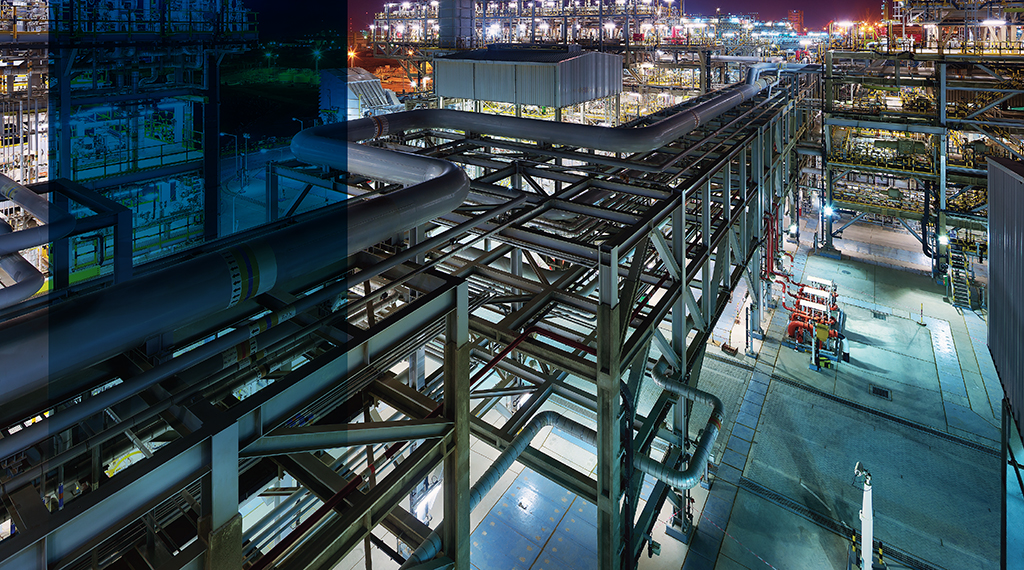
offshore
heartland
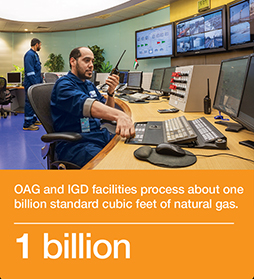




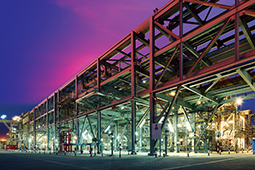
Investment in environmental protection
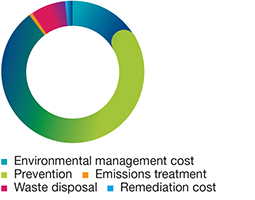
Production volume
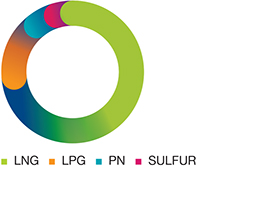
Production lines expand
Further expansions to the gas processing facilities are planned in the future to increase the local gas export by 50%.
Powering the future of Abu Dhabi
ADGAS’ offshore heartland
Various technical difficulties faced during the marine and civil works included unfavorable soil type, installing heavy walls underwater to support the reclaimed land, and adverse weather conditions that obstructed marine operations at the unsheltered location of the IGD facilities on north-western Das, which is exposed to the prevailing waves and currents. These adverse weather conditions seriously hindered progress, especially during winter.
Further constraint to construction was IGD’s location on the Das Island runway flight path. A study was carried out to ensure that the high points of the plant stacks and construction cranes did not impose any risk to daily flights. Special height cranes were only operated at night when no flights were taking place, requiring close coordination with ADMA-OPCO and Abu Dhabi Aviation.
While the civil and marine works were being carried out, the project’s main contractor HHI’s Home Office services including detail engineering, procurement, and fabrication of the process and utilities’ units/modules, were taking place in parallel at HHI’s yards in Ulsan.
Das Island
Das Island is a unique site with a long history in the oil and gas industry – a connection that began in 1953, when the first oil explorations were carried out in Abu Dhabi’s territorial waters. Since then, it has developed into a key strategic hub for Abu Dhabi’s oil and gas industry.
Measuring only 2.5 km² (now 4.8 km² after the recent expansion), Das Island is small in size but plays a major role in the region’s oil and gas industry. It is the operational heart of ADGAS’ business, a source of great pride for everyone at the company, and the home away from home to over 4,000 staff members of ADGAS, ADMA-OPCO, and contractors.
The rectangular island lies just 160 km from the Abu Dhabi coastline, surrounded by the offshore oil fields that it serves.
Das Island was selected as the most suitable base for offshore oil operations by ADMA-OPCO in 1954. When oil production began at the Umm Shaif oil fields in 1962, the island was used as a land base, storage facility, and launch site of ADMA-OPCO’s first oil consignment. Due to its strategic location and first-rate facilities, it remains the main oil storage site for the area to this day.
When ADGAS was established in 1973, Das Island was the natural choice for the region’s first LNG plant. As ADGAS developed and quickly became the leading LNG producer in the region, the island found itself at the center of a lucrative new revenue stream for the ADNOC Group. Das Island has continued to develop over the years and it now accommodates the industrial operations of both ADGAS and ADMA-OPCO.
As the island accommodates thousands of ADGAS and ADMA-OPCO employees year-round, their comfort and well-being is of paramount importance. ADGAS ensures that all necessary services and facilities are freely available to all staff and contractor employees, many of whom work in shifts to keep operations running smoothly and safely round the clock.
The island is home to more than 15 social, sports, and recreational clubs that cater to residents’ favorite hobbies. The island also boasts several shops and restaurants, in addition to convenient medical and administrative services, all designed to promote comfort and well-being for the island’s residents.
Expansion of production lines
ADGAS’s operational core started with the gas liquefaction plant on Das Island, two LNG trains being commissioned in 1977, and a third in 1994 that have total production capacity of about eight million tons. Two OAG trains commissioned in 2010 and three IGD trains in 2013 have all become operational, doubling the company’s capacity and output for gas processing/handling.
The original design capacity of LNG Trains 1 and 2 was 150 tons per hour for each train. In 1990, ADGAS and its strategic customer, the Tokyo Electric Power Company (TEPCO), signed a long-term agreement to expand and consolidate their operations, which prompted ADGAS to build what was then the world’s largest and most advanced LNG train in 1994.
The new LNG train enabled ADGAS to double its production and output levels. Since then, all three trains have consistently operated at 20 percent higher capacity than their original designs, as a result of upgrades and production streamlining carried out by ADGAS experts.
The ADGAS gas liquefaction plant is unique in its ability to process both associated and non-associated gases produced during oil production. LNG Trains 1 and 2 can handle both types of gases at high and/or low pressures, while LNG Train 3 exclusively handles high pressure gas. This versatility is vital because feed gas obtained from Abu Dhabi’s offshore oil fields comprises both associated and non-associated gases.
Associated gas is obtained from the Umm Shaif, Zakum, and Bunduq oil fields, while natural non-associated gas is found at the Abu Al Bukhoosh Khuff, Uweinat, Areaj, Umm Shaif Khuff, and the Cap gas fields. In total, the plant receives 12 distinct gas streams and blends them to produce LNG, LPG, naphtha, and sulfur to meet clients’ requirements. In addition, high pressure dense phase gas is exported to GASCO's facilities to fulfil domestic gas requirements. The plant’s three trains’ capacity is around eight million metric tons a year of LNG, LPG, paraffinic naphtha, and molten sulfur.
ADGAS’ new role
Traditionally, ADGAS has concentrated on export markets, selling LNG and other products mainly to Japan, and the rest of the Far East, maintaining excellent relationships with existing and potential end-users, and ensuring reliable supply.
The last five years have witnessed a shift in the role of ADGAS, with the installation and operation of the ADNOC sole-risk projects, the OAG, and the IGD. OAG Plant has two identical trains processing mainly the associated low pressure gases from ADMA. The gas is dehydrated, compressed to 154 Barg pressure, and sent through a sub-sea pipeline to onshore GASCO facilities for separation of NGL, before being fed to the sales gas header. OAG has production capacity of 200 mmscfd of low pressure Gas.
IGD plant has three identical trains processing 800 mmscfd of high pressure gas from ADMA-HAP, where it is dehydrated, compressed to 154 Barg pressure, and sent to onshore GASCO facilities through the same sub-sea pipeline along with export gas from OAG.
Now, with an increasing emphasis on domestic consumption, and in line with the national energy strategy and Abu Dhabi Economic Vision 2030, ADGAS has worked closely with sister companies to ensure the smooth operation of its facilities, especially ADMA-OPCO, which provides the feed gas, and GASCO, which receives the dehydrated and compressed gas for further processing and transmission to Abu Dhabi. These close partnerships are vital to our business and to the smooth, efficient, and safe operation of our industrial facilities.

